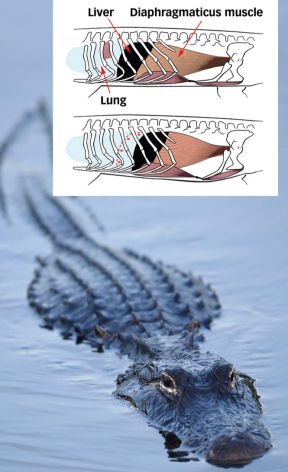Alligators turn out to have an unappreciated power organ for maneuvering underwater: their lungs.

Four sets of muscles in the lower part of the gator torso clench during particular phases of diving and rolling, says T.J. Uriona of the University of Utah in Salt Lake City. These moves squeeze the lungs around in the body cavity, changing buoyancy and tipping the animal’s body this way and that.
“The big picture is that lungs are probably more than just breathing machines,” Uriona says.
Gators use an unusual variety of muscular gadgetry to operate their lungs. For example, a big muscle connects their liver to bones at the base of the torso. This liver piston pulls down viscera and helps draw air into the chest. When the muscle relaxes, the organs rise again, helping press air out of the lungs. Yet when researchers sever this muscle, young alligators still breathe, moving and growing seemingly as well as intact animals, Uriona says.
To look for other functions of these supposed respiratory muscles, Uriona and Utah colleague C.G. Farmer implanted electrodes in the muscles of five young alligators. When the animals dived underwater, the electrodes showed four muscle groups tensing during the downward swoop. The motions pull the lungs back toward the tail, seeming to incline the animal downward, Uriona says.
To test the idea, the researchers duct-taped lead shot to the animals’ tails. When the weighted animals swooped, the muscles worked harder. Weighting animals’ noses, to make a downward dive easier, prompted less muscle activity.
For rolling animals, only one side of the big muscles fired, squeezing the lungs to buoy the upward side.
Buoyancy control could have been the first underwater function for these muscles, with respiratory assistance coming later, the researchers suggest in the April 1 Journal of Experimental Biology.
“This is very cool,” says biomechanicist Frank Fish of West Chester University in Pennsylvania. The discovery fits into his work on alligator death rolls, in which the animal grabs prey and spins on its long axis. In spite of sensational tales of alligators drowning prey with rolls, Fish says he thinks gators mostly use the move to rip a swallowable chunk of meat off a carcass. Fish’s high-speed films reveal that a rolling gator kinks up its tail but doesn’t paddle with its legs during the roll. “It’s like a figure skater tucking in the arms to spin faster,” he says. Lung squeezing could help keep a gator rolling.
Now that Uriona knows what to look for, he says, he is finding similar respiratory muscle moves in snapping turtles and African clawed frogs.






